Manuscript accepted on : 12-June-2019
Published online on: 28-06-2019
Plagiarism Check: Yes
Reviewed by: Prafulla Mohanty
Second Review by: Sashikala Beura
Monitoring of Mite Population and Pest Management Practices in some Apple Orchards in Kashmir Region
Ishana Qadir1 and Ayesha Qamar*2
1,2Section of Entomology, Department of Zoology, Aligarh Muslim University, Aligarh, UP, 202002-India.
Corresponding Author E-mail: ayesha.zoology@gmail.com
DOI : http://dx.doi.org/10.13005/bbra/2757
ABSTRACT: In the present study, a preliminary survey was carried out in two apple orchards (O1 and O2) belonging to the central region of the state of Jammu and Kashmir to ascertain the prevalence of different types of pests infesting the orchards across different phases, i.e., pre-bloom, bloom and post bloom which spread across the months of end March till the harvest stage (apple picking) in October. Among various types of pests documented, the incidence of red mites was highest. Apple scab was recorded highest in the post bloom stage. The mite population was recorded by using Binomial sampling technique and calculating the Cumulative Mite Days (CMD). Mite infested leaves were 24.8% and16% in O1 and O2 respectively. Similarly, CMD increased linearly in O1 reaching to a maximum of 7.17 on the last sampling day, whereas in the 2nd orchard it showed increased to 7.42 on the last sampling day. In addition to monitoring pest population, the pesticide usage regime was also studied and extensive usage of which was recorded in both the orchards. Yellow fly trap with its corresponding synthetic pheromone was used as quantitative sampling device in monitoring the general pest population
KEYWORDS: Apple; Jammu and Kashmir; Pests; Pheromone
Download this article as:| Copy the following to cite this article: Qadir I, Qamar A. Monitoring of Mite Population and Pest Management Practices in some Apple Orchards in Kashmir Region. Biosci Biotech Res Asia 2019;16(2). |
| Copy the following to cite this URL: Qadir I, Qamar A. Monitoring of Mite Population and Pest Management Practices in some Apple Orchards in Kashmir Region. Biosci Biotech Res Asia 2019;16(2). Available from: https://bit.ly/2xBUw5E |
Introduction
In India, apple production is limited to the hill states of Jammu & Kashmir (J&K), Himachal Pradesh (HP), and Uttarakhand (USDA, 2017). As per the report published by USDA in December 2018, India’s apple production is forecasted to improve, rising almost 400,000 to 2.3 million tons from the previous year. The state of J&K is the largest apple producing state in India followed by HP and Uttrakhand. Apple is one of the most important commercially produced horticulture crops grown in J&K. Here it forms one of the best sources of income to the farmers as it is a farm-based, labour intensive and commercially attractive economic activity. Apple cultivation is fast growing in the state because of its high market value, occupying166441 Ha and producing 1882774 MT of apple (Directorate of Horticulture Kashmir, 2018).
The production and quality of apple is poor as compared to that of developed countries because of several factors including pest infestations and crop disease (USDA, 2013). Although a large number of insect pests attack the apple crops, some of them are very serious and need attention for their control. In addition to the insect pests, mites also influence apple crop quality and cause significant economic losses to commercial fruit growers.
A preliminary survey was carried out by various methods to ascertain the prevalence of different types of pests and the control methods employed during bloom and post-bloom seasons for apples in the region of Jammu and Kashmir.
Apple Pests
Fruit pests are of concern to all aspects of apple industry viz the agricultural scientists, traders, and the producers because even a single line of damage on the fruit can render it useless in the market leading to economic losses.
San José Scale
San José scale (Quadraspidiotus perniciosis) (Homoptera: Diaspididae), a native pest of northern China, probably entered the Kashmir valley in the late 19th century or early 20th century (Flanders, 1960). Since its introduction, it has, due to its staggering rate of reproduction, increased both its area of infestation and the number of host- plants it infests. In Kashmir, as many as 70 plant species have been recorded as suitable hosts for the San José scale (Pruthi and Rao, 1951; Sofi, 2006; Anonymous, 2014). These pests overwinter as immature scales (Figure, 1A). Emerging as tiny winged male adults in the spring season and mate with the wingless females. The immature stages called crawlers are seen moving randomly on every part of the plant before settling down permanently. The present-day and common practice control measures consist of single application of commercially available orchard oil alone or in a cocktail with different insecticides at the half inch green bud stage to suppress the overwintered black cap stage and other immature eggs (Mir et al., 2015).The farmers in the present scenario are unaware of the other control techniques regarding its control. If left uncontrolled, it can cause severe damage to the whole tree including bark, branches, and leaves etc, and also cause localized discolorations on the fruit (Figure, 1B).
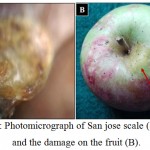 |
Figure 1: Photomicrograph of San jose scale (40x) (A); and the damage on the fruit (B).
|
Red Mites
European red mite Panonychus ulmi (Koch) is another serious arthropod pest that feeds on foliage and reduces apple yield. They are often seen crawling on the newly formed buds and green parts of the plant. On close observation, they can be seen crawling on every part of the leaf, shoot, and stem (Figure 2 A and B). They pose a potential threat to the growing buds and leaves as they feed on them, suck their chlorophyll, and thereby significantly depleting the photosynthesizing ability of the plant causing early senescence. These mites can be generally found on the lower side of the leaf, but as their density increases, they appear on the upper surface as well.
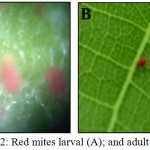 |
Figure 2: Red mites larval (A); and adult stage (B).
|
Other arthropod pests such as weevils, beetles (Figure 3 A and B) and white grubs also cause significant damage to the young plants. White grubs are a serious threat to the young stems (Figure 3 C), the young larvae start eating the tree in or under the bark which interrupts the flow of sap and eventually killing the tree if left untreated. They suck the sap out from young shoots, fruits and flowers causing wilting and premature fruit drop.
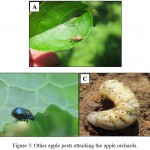 |
Figure 3: Other apple pests attacking the apple orchards.
|
Materials and Methods
Based on the preliminary observation on the prevalence of pests, the sampling was carried out during pre-bloom and bloom (spring season) and post bloom period (early to late summer) continuing till the harvest stage (apple picking) in October. For this, two orchards O1 and O2 with an area of 0.1Ha and 0.35 Ha were selected for the survey. These orchards were located on a slope having uneven peripheries with an average of 100 or more mature apple tree plantations.
In each orchard, monitoring was done for various apple pests and a high prevalence of European red mites was observed. We therefore focused on the sampling of these pests. The trees were selected randomly from every part of the orchard and the leaves infested with mites were counted using binomial method in which the number of infested and un-infested leaves (observing infestation on 25 and 15 leaves on each tree from O1 and O2 respectively) from at least 10-15 trees. We also calculated the Cumulative Mite Density (CMD) by the following formula (Jayasinghe and Mallik, 2010).

Where Pa is the population density at time a, Pbis the population density at time b and Da-b is the number of days between a and b.
Yellow fly trap (Figure 4) with its corresponding synthetic pheromone was used as quantitative sampling device in monitoring the general pest population. These traps were placed in both the orchards at a distance of 100m and were used as a predictive tool for pest infestation.
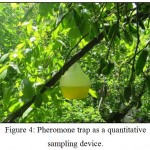 |
Figure 4: Pheromone trap as a quantitative sampling device.
|
Results
Monitoring
By using binomial scheme of sampling European Red mites, it was observed that in O1 the total percentage of mite infested leaves were 24.8% and in O2 the infestation was 16% respectively (Table 1 and 2). Similarly, CMD increased linearly in O1 reaching to a maximum of 7.17 on the last sampling day, whereas in the O2 it showed an increase upto 7.425 on the last sampling day (Table 3 and 4; Figure 5).
Table 1: Total number of Mite infested/un-infested leaves in O1.
| Tree number | Infested leaves | Un-Infested leaves | Total number of leaves |
| 1 | 5 | 20 | 25 |
| 2 | 9 | 16 | 25 |
| 3 | 9 | 16 | 25 |
| 4 | 6 | 19 | 25 |
| 5 | 8 | 17 | 25 |
| 6 | 4 | 21 | 25 |
| 7 | 9 | 16 | 25 |
| 8 | 3 | 22 | 25 |
| 9 | 4 | 21 | 25 |
| 10 | 8 | 17 | 25 |
| 11 | 3 | 22 | 25 |
| 12 | 7 | 18 | 25 |
| 13 | 4 | 21 | 25 |
| 14 | 6 | 19 | 25 |
| 15 | 6 | 19 | 25 |
| Total | 93 | 284 | 375 |
Table 2: Total number of Mite infested/un-infested leaves in O2.
| Tree number | Infested leaves | Un infested leaves | Total number of leaves |
| 1 | 3 | 12 | 15 |
| 2 | 1 | 14 | 15 |
| 3 | 4 | 11 | 15 |
| 4 | 2 | 13 | 15 |
| 5 | 3 | 12 | 15 |
| 6 | 3 | 12 | 15 |
| 7 | 1 | 14 | 15 |
| 8 | 3 | 12 | 15 |
| 9 | 2 | 13 | 15 |
| 10 | 2 | 13 | 15 |
| Total | 24 | 126 | 150 |
Table 3: CMD for O1 at different sampling dates.
| Sample date | Weekly counts mites/leaf | Average counts | Days between counts | Number of days * average |
| Day 1 | 2.3 | 3 | ||
| Day 2 | 1.97 | 2.135 | 3 | 6.405 |
| Day 3 | 2.67 | 2.32 | 3 | 6.96 |
| Day 4 | 1.78 | 2.22 | 3 | 6.66 |
| Day 5 | 3.0 | 2.39 | 3 | 7.17 |
Table 4: CMD for O2 at different sampling dates.
| Sample date | Weekly counts mites/leaf | Average counts | Days between counts | Number of days * average |
| Day 1 | 2.8 | 3 | ||
| Day 2 | 1.8 | 2.3 | 3 | 6.9 |
| Day 3 | 1.67 | 1.735 | 3 | 5.025 |
| Day 4 | 2.08 | 1.875 | 3 | 5.625 |
| Day 5 | 2.87 | 2.475 | 3 | 7.425 |
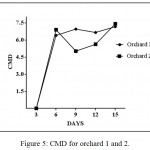 |
Figure 5: CMD for orchard 1 and 2.
|
Control (Chemical) Methods
Early Spring
Fungicides
During pre-bloom and bloom, the weather is generally wet and foggy. This causes a widespread fungal infestation. To protect the trees and fruits from the damage, farmers rely on various fungicides (Table 5), spraying them in different concentrations and proportions evenly on every part of the tree.
Table 5: Fungicides used for spray in pre-bloom.
| Brand name | %Active ingredient | Rate of application | Time of spray | Mode of action |
| Captan | 70.000% captan w/w | Bloom | Contact fungicide | |
| Dithane M-45 | Mancozeb | Bloom | Contact fungicide | |
| Anthracol | Probineb 70% w/w | Bloom period when the color is pink | Contact fungicide | |
| Cantop | Dissolved in 30 ml per 100 l of water | Post bloom, apple is pea sized | ||
| Score | Difenoconazole | 200g are diluted in 150 l of water | Bloom, pink coloured | Systemic fungicide |
| Grapple/Systhane/ Revolve | Myclobutanil | Bloom | Systemic fungicide | |
| Kashtin | Carbendazim 98% w/w | Bloom | Systemic Fungicide |
Orchard oils
Orchard oils are sprayed during pre-bloom, i.e., in the month of March when the trees are in dormant stage. Oil is used as a lubricant; it is known to effectively control San Jose scale eggs, red mite eggs and other harmful insect larvae. Oils form a stable emulsion with water, which upon application, leave a film of optimum stickiness and don’t allow them to hatch. These oils come in various combinations and are applied as a fine spray with the help of sprayers (Table 6).
Table 6: Orchard oils used for spray.
| Trade name | Temp /Time of spray | Effective against | Effects | Directions of use (Farmer) |
| Orchol | Dormant stage/ winter season temperature is 4 | Eggs | Lubrication | 30 l of waters for 1 l oil |
| Mak | Eggs and larvae | Stickiness | – | |
| Tree spray oil HP | 4°C | Eggs and larvae of red mites, San Jose scale. | Lubrication | 2% concentration |
| Diesel + Fish Oil | 4°C | Eggs of San Jose scale | Stickiness and lubrication | 1 l in 8l of water |
Mid-Summer to Apple Picking
Orchards were further surveyed in mid-summer which extends from May to July. In this period, no significant level of pests was observed due to unsuitable weather conditions and temperature recorded as low as 23.42°C. However, the apples presented abundant scab (Figure 6) due to development of secondary spore caused by wet and foggy conditions. However, O2 showed less damage because of higher pesticide use. The Delicious variety of apples grown in this orchard is of greater economic value to the farmers. On further investigation in O1 which has a mixed cultivation of Delicious and Maharaji variety, the former variety was less affected by apple scab as compared to the latter in the same orchard. Moreover, the mites were not observed in either orchard due to the use acaricides during the bloom period.
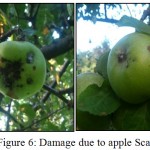 |
Figure 6: Damage due to apple Scab.
|
Discussion
Despite playing an un-doubtful role in crop protection and increasing the crop yields, the risk factors associated with the pesticides cannot be overlooked at all. Injudicious and uncontrolled use of chemical pesticides in agriculture has resulted in several adverse effects. In addition to ecological imbalances, environmental pollution, pesticide residues in food, they are also responsible for causing human and animal health hazards (Georgiadis et al., 2018; Kumari and John, 2019). The direct and indirect exposure to pesticides through various routes in human perspective can result in the accumulation of these toxicants and cause several neuro-degenerative disorders (Sara and Mohammad, 2018; Mehdi and Qamar, 2013). Pesticides in food have increased at alarming rates and show that human exposure has increased about 103 to 105 times higher than induced by inhalation or drinking water (Margni et al., 2002). This occurred because crop protection has been given top priority and poor Research and Development resources available in the past (Amano and Haseeb, 2001). The application of broad spectrum and non-selective pesticides further aggravated the problems and as such sustainable methods need to be adopted.
In view of the above, Government of India adopted an Integrated Pest Management (IPM) plan for overall crop protection and also launched a program regarding this in 1985. The ministry of Agriculture and Farmers Welfare Department of Agriculture, Cooperation & Farmers Welfare Directorate of Plant Protection, Quarantine and Storage collectively oversee the implementation of IPM. Its commencement dates back to 1992 when 26 Central Integrated Pest Management Centres (CIPMCs) were established by merging all Central Plant Protection Stations (CPPS), Central Surveillance Stations (CSS) and Central Biological Control Stations (CBCS). Later, 5 more CIPMCs were established in the 10th Five Year Plan and further 4 centers were established in the 12th Five Year Plan period. As of date, 35 CIPMCs are working in 29 States and 1 Union Territory. IPM Packages have been developed for 87 crops among which some of them include rice, wheat, maize, sorghum, pearl millet, black gram, green gram, gram, pea, groundnut, soybean, rapeseed/mustard, sesame, leguminous vegetables, cucurbitaceous vegetables, brinjal, okra, chilies, cotton, sugarcane, tobacco, citrus, pineapple, sapota, pomegranate, grapes, apple, mango, guava, red gram, tapioca, turmeric, etc. These packages were introduced with the objective of maximizing crop production while minimizing environmental pollution and occupational hazards, and aim to improve ecological farming systems. The major activities of this institution include monitoring of the pest population, conservation of natural predators of pests, field release of bio control agents, and popularization of the IPM technology among farmers. In the previous year (2018), the targets include the pest monitoring of 9 lakh hectares of land and 2200 million biocontrol agent releases. The impact of IPM on certain crops has been commendable and helped in increasing the crop yield from 6.72% to 40.14% in rice and 22.7 % to 26.63 % in cotton. The spray of chemical pesticides was reduced to the extent of 50-100% in rice and 29.96- 50.5% in cotton. Moreover, the use of biopesticides/neem-based pesticides increased from 123 MT during 1994-95 to 63540 MT during 2016-17 according to report published by the ministry of Agriculture and Farmers Welfare Department of Agriculture.
In the present study, we monitored the red mite population using binomial sampling method and CMD technique. Monitoring pest population is an essential cornerstone of IPM. Monitoring is important as it helps to determine presence or absence of pests in a particular area to warrant a future costly treatment. From our study, we found the apples to be most susceptible to mite infestation during pre-bloom period. We therefore expect this study to be helpful in establishing the of the injury thresholds- a key component of the IPM. In our study, we tested commercially available pheromone traps for this purpose, but the experiment was unsuccessful owing to the fact that the lures used in these traps were not optimized for use with apple pests.
Pheromone traps are also important tools deployed extensively in IPM programs for pest surveillance. Several traps have been designed and tested in India to monitor the population of several important pests such as Plutella xylostella, Helicoverpa armigera, Spodoptera litura, Scirpophaga incertulas, Mythimna separate, etc. (Rao et al., 1991; Reddy and Urs, 1996; Pawar et al, 1998; Singh et al., 2006). Although pheromones have established their role in IPM systems, and a lot of research regarding them is under study and one of the but applied researchers and end-users do not realize that how much effort is put into identifying the pheromone blends so that they become species specific and target the pest species in the best possible ways. Since the discovery of insect pheromone by Butenandt, 1959, there has been an enormous increase in the basic and applied research in pheromones which has given way to the exceptionally diverse and effective use of pheromone in IPM. The pheromone profiles of over 3000 insect species are now known, many of which are multicomponent mixtures, present in nanogram or picogram amounts.
From this field report, we also concluded that there is a considerable increase in the pesticides use. The demand of agrochemicals is directly linked to the types of crop grown, availability of the chemicals and the higher probability of achieving the predicted financial targets by using these chemicals. Among the different crops grown in Jammu and Kashmir, the increase in apple production has been steady due to the increased use of fertilizers and pesticides (Baba et al., 2012). The lack of proper quarantine measures in the state of Jammu and Kashmir has resulted in the indiscriminate use of these chemicals. Moreover, the farmers are not properly educated in farming practices and the choice of the proper pesticide usage lies in the hands of unlicensed dealers, which sell these pesticides according to the market demand (Baba et al., 2012). The proper guidelines for spray schedules are not adopted. Farmers use agro-chemicals in doses and concentrations much above the recommended levels to increase the crop yields. The sale of banned pesticides, such as Endosulfan, as well as unlabeled and spurious pesticides has further aggravated these problems. The pesticides available in the market are less efficient and in many cases the pests have already developed resistance against them so much higher doses are applied in the field.
An immediate need is the implementation of proper methods to control these pests. The selection and use of control methods, and sampling procedures, are the strategies and tactical components of IPM programs. The classical integrated control programs for apple orchards provided a framework for the successful implementation of IPM programs in Nova Scotia, Canada (Pickett and Patterson, 1953; Pickett et al., 1958), and for cotton pests in Peru (Dout and Smith, 1971). To promote IPM in developing countries, the UN-FAO provided necessary coordination, leadership and resources to launch IPM programs (FAO, 1968).
In the present scenario, community participation will play an important role in the successful adoption and implementation of any IPM program. Moreover, mass media is an important tool to bridge the communication gap between the scientists and the common farmers. Community radio stations in vernacular languages can prove a milestone to improve the agriculture systems in India (Qamar and Qadir, 2017). Moreover, this part of the study will be helpful in shedding some light on the control tactics in vogue and the need of better control strategies in future.
References
- Amano H and Haseeb Recently-proposed methods and concepts of testing the effects of pesticides on the beneficial mite and insect species: study limitations and implications in IPM. Appl Entomo Zool. 2001;(36):1-11.
- Management of pests on apple in Kashmir, Division of Entomology, 2014; Directorate of Extension education, SKUAST-K, Shalimar.
- Baba S. H, Wani M. H, Zargar B. A, Wani S. A, Kubrevi S.S. Pesticide Delivery System in Apple GrowingBelt of Kashmir Valley. Agri Econ Res., 2012; 22:435-444.
- Butenandt VA, Beckmann R, Stamm D and Hecker E (1959). Naturforsch.14:283-284.
- Directorate of Horticulture, Kashmir. 2018; District-Wise/Kind-wise Area under major Horticulture Crops in J&K State for the Year 2017-18.
- Dout R. L and Smith R. F (CB Huffaker). The pesticide syndrome—diagnosis and prophylaxis. . New York: 1971; In Biological Control, ed., Plenum.511 pp; pp. 3–15.
- Flanders S. W. The status of San Jose scale parasitization (including biological notes) J Econ Entomo. 1960;(53):757-759.
- Food and Agriculture Organization 1968. FAO Panel of Experts on Integrated Pest Control, 1st, Sept. 12–22, 1967. Rome, Italy: FAO-UN, Meet. Rep. PL/1967/M/7.19 pp.
- Georgiadis N, Tsarouhas K, Tsitsimpikou C, Vardavas A, Rezaee R, Germanakis I, Tsatsakis A, Stagos D and Kouretas D. Pesticides and cardiotoxicity. Where do we stand? Toxicol Appl Pharmacol. 2018; (6):1-14.
- Jayasinghe G. G and Mallik B. Growth Stage Based Economic Injury Levels for Two Spotted Spider Mite, Tetranychus urticae Koch (Acari, Tetranychidae) on Tomato, Lycopersicon esculentum Trop Agri Res. 2010;(22):54-65.
- Kumari D and John Health risk assessment of pesticide residues in fruits and vegetables from farms and markets of Western Indian Himalayan region. Chemosphere. 2019;(224): 162-167.
- Margni M, Rossier D , Crettaz P and Jolliet O. Life cycle impact assessment of pesticides on human health and ecosystems. Agric, Ecosyst Environ. 2002; 93:379–392.
- Mehdi S. H and Qamar A. Paraquat-induced ultrastructural changes and DNA damage in the nervous system is mediated via oxidative-stress-induced cytotoxicity in Drosophila melanogaster. Toxicol Sci. 2013;134(2):355-65.
- Mir M. A, Nehru R. K, Ahmad S, Majid S and Jalaludin P. Efficacy of some horticultural mineral oils (HMO’s) against Quadraspidiotus perniciosus (Comstock) in Kashmir. Green Farming. 2015;(6):1126-1129.
- Pawar C. S and Sithanantham S and Bhatnagar V. S and Srivastava C. P and Reed W. The development of sex pheromone trapping of Heliothis armigera at ICRISAT, India. Trop Pest Manag. 1988;(34):39-43.
- Pickett A. D and Patterson N. A. The influence of spray programs on the fauna of apple orchards in Nova Scotia. IV. A review. Can Entomo. 1953;(85):472-78.
- Pickett J. H, Putman W. L and LeRoux E. J. Progress in harmonizing biological and chemical control of orchard pests in eastern Canada. Proceedings of the 10th International Congress on Entomology. 1958;(3):169.
- Pruthi H. S and Rao V. P. San Jose scale in India.,1951; Technical Publication No.3, ICAR Bulletin No.71.
- Qamar A and Qadir I. From corridors of science to the vast fields on the shoulders of media. International conference on communication, culture and sustainable development: key issues and challenges. 2017; Department of Mass Communication AMU, Aligarh.
- Ranga Rao G. V, Wightman J. A and Ranga Rao V. The development of a standard pheromone trapping procedure for Spodoptera litura (F) (Lepidoptera: Noctuidae) population in groundnut (Arachis hyopogaea L) crops. Tropi Pest Manag. 1991;(37):37-40.
- Reddy G and Urs K. Studies on the Sex pheromone of the diamondback moth Plutella xylostella (Lepidoptera: Yponomeutidae) in India. Bull Entomol Res. 1996; (86):585-590.
- Sara M and Mohammad The link of organophosphorus pesticides with neurodegenerative and neurodevelopmental diseases based on evidence and mechanisms. Toxicology. 2018;(409):44-52
- Singh R, Mahal M. S and Kajal V. K. Influence of pheromone traps in management of yellow stem borer, Scirpophaga incertulas Walker on basmati rice. Insect Sci. 2006;(19):22-26.
- Sofi M. Studies on the current status of San Jose scale Quadraspidiotus perniciosus (Comstock) and its management on apple. 2006; Post-doctoral thesis. Division of Entomology. Sher-e-kashmir University of Agricultural Sciences & Technology of Kashmir.
- USDA, Foreign Agriculture Service, Gain report 2013. https://gain.fas.usda.gov/Recent%20GAIN%20Publications/2013%20Apple%20Product%20Brief_New%20Delhi_India_6-19-2013.pdf.
- USDA, Foreign Agriculture Service, Gain report 2017. https://gain.fas.usda.gov/Recent%20GAIN%20Publications/Fresh%20Deciduous%20Fruit%20Annual_New%20Delhi_India_11-22-2017.pdf.
- USDA. Foreign Agricultural Service 2018. Fresh Deciduous Fruit: World Markets and Trade (Apples, Grapes, & Pears).

This work is licensed under a Creative Commons Attribution 4.0 International License.





